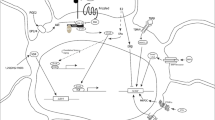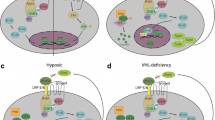Abstract
Objective
Our previous study suggested that suppression of Wnt/β-catenin signaling by increasing serum Wnt co-receptor inhibitors, sclerostin and Dickkopf-1, impairs bone formation in the first week after starting glucocorticoid therapy. The objective of this study was to investigate the involvement of the Wnt/β-catenin signaling pathway and its clinical significance in the subsequent suppression of bone formation.
Methods
A total of 53 patients with systemic autoimmune diseases who received initial glucocorticoid therapy with prednisolone (30–60 mg daily) were prospectively enrolled. We measured serum levels of Wnt3a and Wnt inhibitors, secreted Frizzled-related protein 1 (sFRP-1) and Wnt inhibitory factor 1 (Wif-1), before starting glucocorticoid therapy and every week for 4 weeks after its initiation.
Results
Serum levels of sFRP-1 and Wif-1 slightly decreased compared with before glucocorticoid therapy from the second week. The serum Wnt3a level decreased from the first week. The ratios of Wnt3a to sFRP-1 and that of Wnt3a to Wif-1 both decreased from the first week onward.
Conclusion
The reduction of the ratio of Wnt3a to Wnt inhibitors, sFRP-1 and Wif-1, suppresses Wnt signaling, which may result in impaired bone formation. Taken together with our previous studies, glucocorticoids may suppress Wnt signaling by inhibiting co-receptors of the Wnt/β-catenin signaling pathway in the early phase of glucocorticoid therapy and inhibiting its ligand in the subsequent weeks, which together impair bone formation.
Key Points • The decrease in Wnt pathway–related molecules by glucocorticoids impairs bone formation. • Glucocorticoids inhibit co-receptors of Wnt signaling in the early phase of therapy. • Glucocorticoids inhibit ligands of Wnt signaling in the subsequent phase of therapy. |




Similar content being viewed by others
References
Van Staa TP, Leufkens HG, Abenhaim L, Zhang B, Cooper C (2000) Use of oral corticosteroids and risk of fractures. J Bone Miner Res 15:993–1000
Güler-Yüksel M, Hoes JN, Bultink IEM, Lems WF (2018) Glucocorticoids, inflammation and bone. Calcif Tissue Int 102:592–606
Suzuki Y, Nawata H, Soen S, Fujiwara S, Nakayama H, Tanaka I, Ozono K, Sagawa A, Takayanagi R, Tanaka H, Miki T, Masunari N, Tanaka Y (2014) Guidelines on the management and treatment of glucocorticoid-induced osteoporosis of the Japanese Society for Bone and Mineral Research: 2014 update. J Bone Miner Metab 32:337–350
Van Staa TP, Leufkens HG, Cooper C (2002) The epidemiology of corticosteroid-induced osteoporosis: a meta-analysis. Osteoporos Int 13:777–787
Canalis E, Mazziotti G, Giustina A, Bilezikian JP (2007) Glucocorticoid-induced osteoporosis: pathophysiology and therapy. Osteoporos Int 18:1319–1328
Seibel MJ, Cooper MS, Zhou H (2013) Glucocorticoid-induced osteoporosis: mechanisms, management, and future perspectives. Lancet Diabetes Endocrinol 1:59–70
Guañabens N, Gifre L, Peris P (2014) The role of Wnt signaling and sclerostin in the pathogenesis of glucocorticoid-induced osteoporosis. Curr Osteoporos Rep 12:90–97
Canalis E (2013) Wnt signalling in osteoporosis: mechanisms and novel therapeutic approaches. Nat Rev Endocrinol 9:575–583
Baron R, Kneissel M (2013) WNT signaling in bone homeostasis and disease: from human mutations to treatments. Nat Med 19:179–192
Monroe DG, McGee-Lawrence ME, Oursler MJ, Westendorf JJ (2012) Update on Wnt signaling in bone cell biology and bone disease. Gene 492:1–18
Rossini M, Gatti D, Adami S (2013) Involvement of WNT/β-catenin signaling in the treatment of osteoporosis. Calcif Tissue Int 93:121–132
Ke HZ, Richards WG, Li X, Ominsky MS (2012) Sclerostin and Dickkopf-1 as therapeutic targets in bone diseases. Endocr Rev 33:747–783
Moester MJ, Papapoulos SE, Löwik CW, van Bezooijen RL (2010) Sclerostin: current knowledge and future perspectives. Calcif Tissue Int 87:99–107
Bodine PV, Billiard J, Moran RA, Ponce-de-Leon H, McLarney S, Mangine A, Scrimo MJ, Bhat RA, Stauffer B, Green J, Stein GS, Lian JB, Komm BS (2005) The Wnt antagonist secreted frizzled-related protein-1 controls osteoblast and osteocyte apoptosis. J Cell Biochem 96:1212–1230
Surmann-Schmitt C, Widmann N, Dietz U, Saeger B, Eitzinger N, Nakamura Y, Rattel M, Latham R, Hartmann C, von der Mark H, Schett G, von der Mark K, Stock M (2009) Wif-1 is expressed at cartilage-mesenchyme interfaces and impedes Wnt3a-mediated inhibition of chondrogenesis. J Cell Sci 122:3627–3637
Kawazoe M, Kaneko K, Shikano K, Kusunoki N, Nanki T, Kawai S (2018) Glucocorticoid therapy causes contradictory changes of serum Wnt signaling-related molecules in systemic autoimmune diseases. Clin Rheumatol 37:2169–2178
Bertouch JV, Roberts-Thompson PJ, Feng PH, Bradley J (1983) C-reactive protein and serological indices of disease activity in systemic lupus erythematosus. Ann Rheum Dis 42:655–658
Gabay C, Gay-Croisier F, Roux-Lombard P, Meyer O, Maineti C, Guerne PA, Vischer T, Dayer JM (1994) Elevated serum levels of interleukin-1 receptor antagonist in polymyositis/dermatomyositis. A biologic marker of disease activity with a possible role in the lack of acute-phase protein response. Arthritis Rheum 37:1744–1751
Kermani TA, Schmidt J, Crowson CS, Ytterberg SR, Hunder GG, Matteson EL, Warrington KJ (2012) Utility of erythrocyte sedimentation rate and C-reactive protein for the diagnosis of giant cell arteritis. Semin Arthritis Rheum 41:866–871
Tse WY, Cockwell P, Savage CO (1998) Assessment of disease activity in systemic vasculitis. Postgrad Med J 74:1–6
Bagnari V, Colina M, Ciancio G, Govoni M, Trotta F (2010) Adult-onset Still’s disease. Rheumatol Int 30:855–862
Wang FS, Lin CL, Chen YJ, Wang CJ, Yang KD, Huang YT, Sun YC, Huang HC (2005) Secreted frizzled-related protein 1 modulates glucocorticoid attenuation of osteogenic activities and bone mass. Endocrinology 146:2415–2423
Zhou M, Wu J, Yu Y, Yang Y, Li J, Cui L, Yao W, Liu Y (2018) Polygonum multiflorm alleviates glucocorticoid-induced osteoporosis and Wnt signaling pathway. Mol Med Rep 17:970–978
Belaya ZE, Rozhinskaya LY, Melnichenko GA, Solodovnikov AG, Dragunova NV, Iljin AV, Dzeranova LK, Dedov II (2013) Serum extracellular secreted antagonists of the canonical Wnt/β-catenin signaling pathway in patients with Cushing’s syndrome. Osteoporos Int 24:2191–2199
Tang L, Lu W, Huang J, Tang X, Zhang H, Liu S (2019) miR-144 promotes the proliferation and differentiation of bone mesenchymal stem cells by downregulating the expression of SFRP1. Mol Med Rep 20:270–280
Wang SY, Liu YY, Ye H, Guo JP, Li R, Liu X, Li ZG (2011) Circulating Dickkopf-1 is correlated with bone erosion and inflammation in rheumatoid arthritis. J Rheumatol 38:821–827
Ma Y, Zhang X, Wang M, Xia Q, Yang J, Wu M, Han R, Chen M, Hu X, Yuan Y, Liu R, Jiang G, Pan G, Zou Y, Xu S, Pan F (2018) The serum level of Dickkopf-1 in patients with rheumatoid arthritis: a systematic review and meta-analysis. Int Immunopharmacol 59:227–232
Fassio A, Adami G, Giollo A, Viapiana O, Malavolta N, Saviola G, Bortolotti R, Idolazzi L, Bertoldo F, Rossini M, Gatti D (2020) Acute effects of glucocorticoid treatment, TNFα or IL-6R blockade on bone turnover markers and Wnt inhibitors in early rheumatoid arthritis: a pilot study. Calcif Tissue Int 106:371–377
Fassio A, Adami G, Idolazzi L, Giollo A, Viapiana O, Vantaggiato E, Benini C, Rossini M, Dejaco C, Gatti D (2020) Wnt inhibitors and bone turnover markers in patients with polymyalgia rheumatica and acute effects of glucocorticoid treatment. Front Med (Lausanne) 7:551
Pelletier S, Dubourg L, Carlier MC, Hadj-Aissa A, Fouque D (2013) The relation between renal function and serum sclerostin in adult patients with CKD. Clin J Am Soc Nephrol 8:819–823
Chung YE, Lee SH, Lee SY, Kim SY, Kim HH, Mirza FS, Lee SK, Lorenzo JA, Kim GS, Koh JM (2012) Long-term treatment with raloxifene, but not bisphosphonates, reduces circulating sclerostin levels in postmenopausal women. Osteoporos Int 23:1235–1243
Gatti D, Viapiana O, Adami S, Idolazzi L, Fracassi E, Rossini M (2012) Bisphosphonate treatment of postmenopausal osteoporosis is associated with a dose dependent increase in serum sclerostin. Bone 50:739–742
Cosman F, Crittenden DB, Adachi JD, Binkley N, Czerwinski E, Ferrari S, Hofbauer LC, Lau E, Lewiecki EM, Miyauchi A, Zerbini CA, Milmont CE, Chen L, Maddox J, Meisner PD, Libanati C, Grauer A (2016) Romosozumab treatment in postmenopausal women with osteoporosis. N Engl J Med 375:1532–1543
Saag KG, Petersen J, Brandi ML, Karaplis AC, Lorentzon M, Thomas T, Maddox J, Fan M, Meisner PD, Grauer A (2017) Romosozumab or alendronate for fracture prevention in women with osteoporosis. N Engl J Med 377:1417–1427
Funding
This study was partly supported by a Project Research Grant (No. 17-12, 18-26) from Toho University School of Medicine to MK; the Nukada scholarship for Medical Research from Toho University School of Medicine to MK; a Research Promotion Grant from Toho University Graduate School of Medicine (No. 17-01) to TN; the Program for the Strategic Research Foundation for Private Universities (S1411015) from the Ministry of Education, Culture, Sports, Science, and Technology, Japan to TN; and the Private University Research Branding Project from the Ministry of Education, Culture, Sports, Science, and Technology, Japan to TN.
Author information
Authors and Affiliations
Corresponding author
Ethics declarations
Disclosures
None.
Ethical standards
This study was approved by the ethics committee of Toho University Omori Medical Center (approval number 24-78, 25-215, M20010) and complied with the 1964 Declaration of Helsinki and its later amendments and Ethical Guidelines for Medical and Health Research Involving Human Subjects by Ministries of Education, Culture, Sports, Science and Technology and Health, Labour and Welfare of the Japanese Government. All subjects provided written informed consent before enrollment.
Additional information
Publisher’s note
Springer Nature remains neutral with regard to jurisdictional claims in published maps and institutional affiliations.
Rights and permissions
About this article
Cite this article
Kawazoe, M., Kaneko, K. & Nanki, T. Glucocorticoid therapy suppresses Wnt signaling by reducing the ratio of serum Wnt3a to Wnt inhibitors, sFRP-1 and Wif-1. Clin Rheumatol 40, 2947–2954 (2021). https://doi.org/10.1007/s10067-020-05554-x
Received:
Revised:
Accepted:
Published:
Issue Date:
DOI: https://doi.org/10.1007/s10067-020-05554-x




